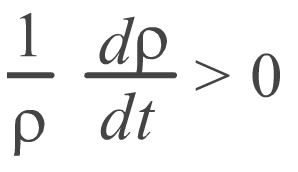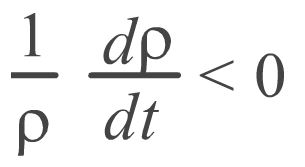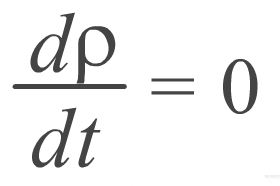The Continuity Equation
Let's consider the continuity equation, which is a mathematical representation of the conservation of mass (which, when applied to the troposphere, simply means that air is neither created nor destroyed):
The term on the left-hand side represents the fractional rate of change of mass in a certain volume. The term on the right-hand side represents three-dimensional convergence or divergence.
Therefore, this equation means that, assuming the mass is kept constant within a certain volume, an increase of the density:
can only occur under convergence conditions:
On the other hand, a decrease of the density:
can only occur under divergence conditions:
Now consider the atmosphere to be incompressible, that is, the density of an air parcel does not change. In this case:
therefore, for an incompressible atmosphere, the continuity equation is simply:
So, a non-divergent atmosphere explains why horizontal convergence forces vertical divergence. And vertical divergence means vertical motion if the horizontal convergence is happening close to the surface!
A study of northwestern Spain in 1997 showed that for dry air, the number of fires was higher if the troposphere was unstable, as this situation is related to an increase of wind speed at the surface, according to the continuity equation.
Curiously, in the same study it has been found statistically that for moist air (when there is less to worry about!) the opposite happened - the number of fires was lower with an unstable troposphere than with a stable one. The physical explanation for this apparent contradiction lies in the following:
For a wet environment, the horizontal convergence that occurs at the surface under unstable conditions is a "wet horizontal convergence". Therefore, it reduces the evaporating capacity of the atmosphere over the vegetation and prevents the drying of the atmosphere. In this way, a wet unstable atmosphere is the less risky situation for fires.
The same study also states that:
- Days more favorable for ignition are also more favorable for development.
- Days less favorable for ignition are even less favorable for development.
When a fire has been ignited, it generates its own circulation and humidity becomes the most important parameter for development (instead of the stability of the initial atmospheric column).
With this information, can you now order the following atmospheric conditions from lowest to highest risk of fire? (Use the dropdown menu to choose the answer that best completes the statement.)
So, to summarize, if a three-dimensional weather view is considered, an unstable dry low troposphere will be the worst scenario for a firefighter! Moisture is the key factor, so stable dry vertical profiles should be viewed as the next most hazardous conditions for a fire. Therefore, the two less risky conditions for fire involve moist lower layers. Now, remember that stability has been found to have a different significance for dry and moist conditions. Again, the risk is higher for moist stable than for moist unstable!







